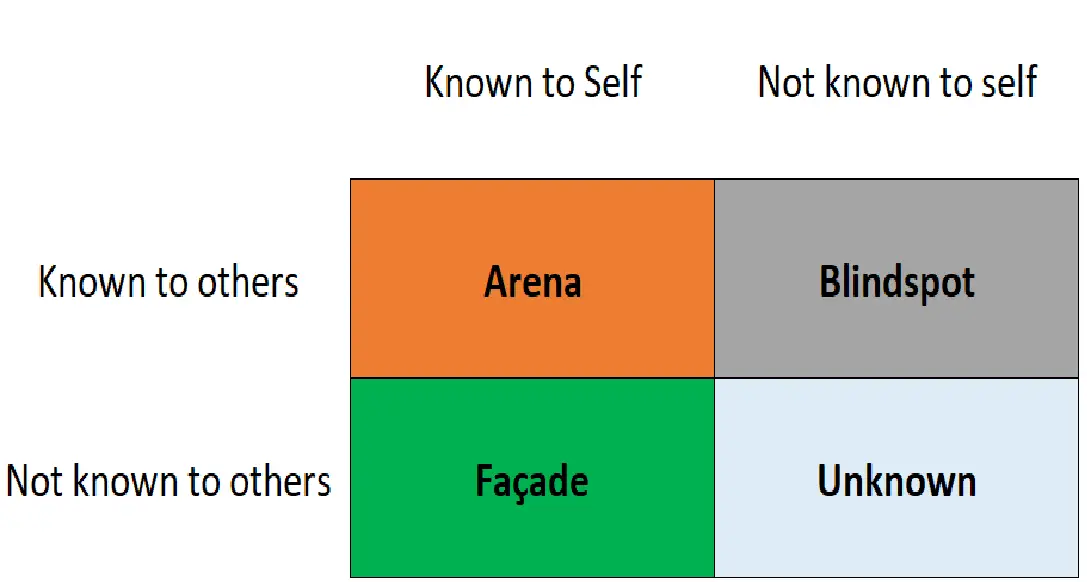The use of Johari window as a tool for employee feedback enables quick identification of the person in front of us and promotes an efficient training initiation process and custom feedback

What is Johari Window?
Psychologists Joe Loft and Harry Ingram have built a graphic model that describes interpersonal behavior that allows you to give and receive information about yourself and the environment. The model is made up of 4 windshields, where it is used as self-analysis parameters on the outside for environmental analysis parameters and on the inside:
Windshield #1 (Blindspot) has a situation where the environment knows something about me that I don't know about myself. For example: In my job as a sales representative I tend to raise my voice without paying attention.
In windshield #2 (Arena) we will find the absoulute truth, as here we see and hear things about the person that the person knows and wants to expose to the environment. For example: a person who smokes and the environment knows he smokes.
In windshield #3 (Unknown) we haveinformation that the person is not aware of and so is the environment . In initiation and training proceudres we most often do not turn on this windshield because it is not recognizable. Sometimes, some of the information goes from the subconscious to the conscious at some point and then it becomes visible or hidden and existing behavior can be changed / improved.
In windshield #4 (Facade) we find the hidden, behavior and ways of thinking that it exists in me, but the environment is not aware of them. For example: a person who smokes but hides it from the environment.
Many managers use the Gohari window as a management tool in providing feedback, decision-making, training and employee training. The Johari window can be used as a tool for learning soft skills. Personally, I have performed and am currently using the tool in training for various management positions such as: Experts, Seniors and Team Leaders at the beginning of their management career.
Johari window in employee apprenticeship processes
The Johari window model allows us to diagnose types of behaviors and situations. As a result of the diagnostic process, feedback and training style, it can be adapted personally to the employee. For example, let's take a manager in a call center who is interested in trainin a sales representative:
Windshield # 1 - The manager noticed that the representative was very aggressive in his calls, which kept customers from closing. The rep is unaware of this and thinks he is doing a great job. In this case, if the manager chooses to give direct feedback, the representative might be unsatisified and disagree with the content of the feedback. The feedback that is recommended in this type of situation is "self-feedback". In this kind of feedback, the manager asks questions and guides the employee. In practice, the trainee gives feedback to himself. Questions for example: How was your conversation with the customer? Did you feel that you were aggressive with the customer, or offer?
Windshield # 2 - The manager noticed that the employee is often late for work. The employee is aware of this and apologizes several times over the matter. Since both the employee and the manager are aware of the situation, there is no reason to go round and you can definitely give the employee direct feedback and ask what he intends to do to improve the issue.
Windshield # 3 - Since the manager is unaware of the behavior and the employee is unaware of it, feedback cannot be held until the behavior becomes visible
Windshield # 4 - The manager feels that something is wrong and the employee's motivation is low, but does not know the reason for it. Yesterday's sales representative scores has been lawer than ususal is not in the mood for work. It might be a situation from the employee's personal life and some will say that the manager has no right to intervene. Still, many managers are involved, helping, and giving tips to their employees even on non-work related issues. Most often these workers are more harnessed and high-performing. So how does the employee open up? Take him for a personal, sensitive conversation. We share that it is our personal feeling that something is wrong and we are here for the employee and on his side. In most cases, if there is a close relationship between the employee and the employer, the employee will tell and then we can help him raise the motivation. If there is no closs relationship, at the moment of a crisis, there may be a golden opportunity to help and create one.
Using a Gohari window tool can be done in employee training, recruitment and apprenticeship processes in all areas including finance, sales, call centers, marketing and more. Many organizations take advantage of the tool's simplicity and it is sometimes added as part of management workshops or in combination with other management tools such as the Efrat model.
About the writer
Roy Barak is a consultant and trainer in the field of management and call centers, holds a Masters degree in Business Administration and has over 15 years of experience working with the largest global organizations.
Other Articles you might like:
- 10 tips that will change your business
- Why is it important to hire a business consultant
- Amazing tips for team meetings





